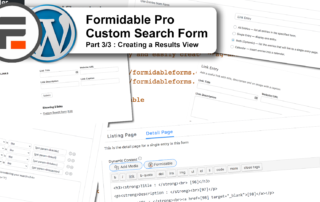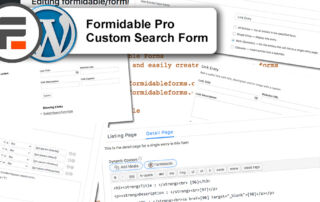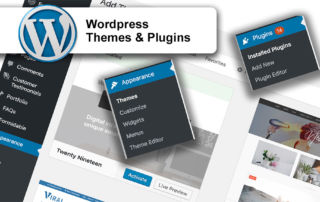Create a results view with Formidable Pro
This is the last of a series of three tutorials showing you how to create a form using Formidable Pro that you can use to search entries that were created by a form created in the first exercise. In the second exercise you created the search form and in this last exercise , results from a search will be presented in this list (called a 'View') that we're going to make here. This last tutorial concerns itself with the creation of the data view.
Create a data entry form with Formidable Pro
This is the first of a series of three tutorials showing you how to create a form using Formidable Pro that you can use it to search entries that were created by a form created in this exercise. Results will be presented in a list and eventually be viewable and editable from the front end. This first tutorial concerns itself with the creation of the data entry form.
Create a search form with Formidable Pro
This is the second of a series of three tutorials showing you how to create a form using Formidable Pro so that you can use it to search entries that were created by a form created in the previous exercise. Results will be presented in a list and eventually be viewable and editable from the front end. This second tutorial concerns itself with the creation of the search form.
Create a custom Search Form with Formidable Pro in WordPress
I thought that I'd try and address the situation by presenting a tutorial that showed you how to create a custom Search Form with Formidable Pro to search through multiple records for specific information and return the results in a well-laid-out format.
Captivate ELearning Planning Assets
Captivate ELearning Planning Assets After much deliberation and multiple requests from students, I've decided to release a number of documents that anyone in the eLearning space should find useful, particularly developers that use Adobe Captivate. In previous blog posts, I've detailed some of the processes and procedures that I use in developing eLearning projects, encompassing strategy, planning and development. In this post I've decided to abbreviate the instruction, and simply provide you with some of the mindmaps that I use in my projects. The content is by no means all-encompassing, nor even complete if you look carefully at the [...]
Multistate objects in Captivate
This tutorial shows how to use multistate objects in Captivate with simple actions. It's an incredibly powerful way to create efficient and engaging eLearning applications. What are multistate objects? Before we start, let’s talk about what a multistate object is, and why you might want to use multistate objects in Captivate. It should be mentioned here that we’re going to be working with Smart Shapes in this exercise. The most obvious multistate object is a button, where the states represent what you might see when you roll over, press and release the button, (effectively the ‘visited’ state), as well [...]
How to use a Javascript timer in Captivate
Before we start, lets scope the reason why you might want to use any timer in Captivate, let alone a Javascript timer. If you’ve ever made Captivate Quiz slides, you know that you can easily set up a scenario where the user only has a finite amount of time to answer a question, and that you can create a customised message to let them know when their time is up. But you have to be using a Quiz slide to do this, and displaying the elapsed time is not possible out of the box. This tutorial shows how you [...]
Planning a website – Themes and Plugins
Planning Wordpress website - Themes and Plugins Here's the second in the series about planning a website. In case you missed the first one, check out Planning a Website - a workflow based approach , the first in the series. Thanks to one of my students who suggested that I should formalise in a post what I usually talk about in class. Cheers Fiona, this one's for you! This post deals with two of the mission-critical elements in a Wordpress website development - choosing Themes and Plugins. If you have chosen Wordpress as your content management system, then you [...]
Captivate progress bar using Javascript
Captivate Progress bar using Javascript One of the things that's constantly being asked for by clients and students alike is a Captivate progress bar. I know there's one already built in to the Skin Editor, which takes a simple click to turn on or off. You can even disable it on Quiz slides. You can even customise it to a certain extent. One thing about progress bars is that you can use them to navigate backwards or forwards. Videos from YouTube and Vimeo, audio files, you name it, they all use a similar concept. And we're well used to [...]
Captivate 2019 Branching Navigation
Captivate 2019 Branching Navigation Since Adobe Captivate 2019 was launched, there have been a few really interesting improvements that have totally changed the way I build interactive branching navigation. Previously, if I wanted users to choose a module to complete from a menu and then be returned to the menu to pick up the next module when they had finished (with a visual indicator that certain modules had been completed ), I would have had to either make a bunch of Advanced Actions, or write some custom Javascript. It was just painfully laborious, but now (with a couple of [...]












 | © 2014 John Ryan Design | All Rights Reserved | 100 percent Australian |
| © 2014 John Ryan Design | All Rights Reserved | 100 percent Australian |